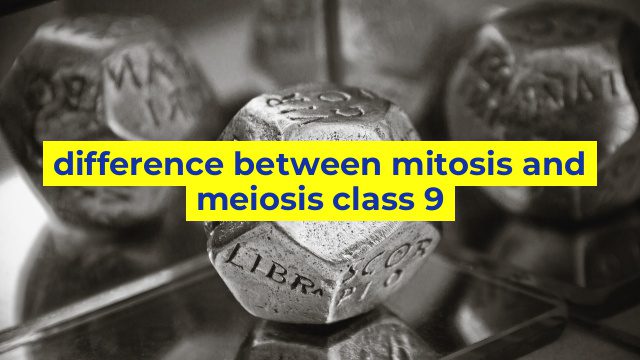The Key Differences Between Mitosis and Meiosis in Class 9 Biology
Mitosis and meiosis are two biological processes involved in the replication and division of cells. While both these processes have similarities, they differ in various ways that affect how cells replicate and how genetic information is inherited.
Mitosis
Mitosis is the process of cell division that leads to the production of two identical daughter cells. This process takes place in somatic cells for growth, repair, or replacement of damaged cells. In mitosis, the DNA is replicated once, and the cell divides into two new cells. The cells produced are identical to the parent cell and contain a full set of chromosomes.
The process of mitosis can be broken down into four stages: prophase, metaphase, anaphase, and telophase. During prophase, the chromatin condenses into visible chromosomes, and spindle fibers form. In metaphase, the chromosomes align along the midline of the cell. During anaphase, the chromosomes split and move to opposite sides of the cell. Finally, during telophase, the cells split into two daughter cells.
Meiosis
Meiosis, on the other hand, is the process of cell division that leads to the production of four genetically diverse daughter cells. This process takes place in reproductive cells, where the genetic information is passed on to the offspring. In meiosis, the DNA is replicated once, but the cell divides into four new cells, each with half the number of chromosomes as the parent cell.
Meiosis is a more complex process than mitosis that has two stages: meiosis I and meiosis II. During meiosis I, homologous chromosomes pair up and exchange genetic information through a process called crossing over. This leads to genetic variation among the daughter cells. During meiosis II, the cells divide again to produce four genetically diverse daughter cells.
The Key Differences
There are several key differences between mitosis and meiosis, including:
– Mitosis leads to the production of two identical daughter cells, whereas meiosis leads to the production of four genetically diverse daughter cells.
– In mitosis, the cells produced are identical to the parent cell, whereas in meiosis, the cells produced have half the number of chromosomes as the parent cell.
– Mitosis occurs in somatic cells, whereas meiosis occurs in reproductive cells.
– Mitosis involves four stages, whereas meiosis involves two stages.
– Mitosis results in growth, repair, or replacement of damaged cells, whereas meiosis leads to the production of gametes (sperm and egg cells) for sexual reproduction.
In conclusion, understanding the differences between mitosis and meiosis is essential in class 9 biology as it aids in the comprehension of how cells divide and inherit genetic information. Both these processes are critical in various aspects of life, including growth, repair, and reproduction.
Table difference between mitosis and meiosis class 9
| Mitosis | Meiosis | |
|---|---|---|
| Definition | Process of a single cell dividing into two identical daughter cells | Process of a single cell dividing into four genetically different daughter cells |
| Number of divisions | One | Two |
| Number of daughter cells produced | Two identical daughter cells | Four genetically different daughter cells |
| Chromosome number in daughter cells | Same as parent cell | Half of the parent cell |
| Role in organism | Growth and repair of tissues, asexual reproduction | Production of gametes for sexual reproduction |
| Crossing over | Does not occur | Occurs during prophase I, resulting in genetic recombination |
| Independent assortment | Does not occur | Occurs during metaphase I, resulting in genetic variation |
